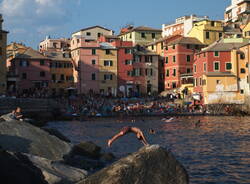The ingenious Silvio Mix, the futurist “rock star” who died in Gallarate
The powerful, entertaining and chaotic Mix was born on 30 December, 1900. He was the child of the extraordinary melting pot that was the Austro-Hungarian empire, and was at the centre of the Futurist movement in Trieste, Florence and Paris.
Over the years, we have often heard about Futurism as a curious diversion in the overview of Italian culture; it was an interesting provocation that was destined to leave few traces. Some have described it in even duller terms, such as those used, in 2018, by the then group leader of the Alternative für Deutschland, in the German Parliament, to describe the Nazi dictatorship (“ein Vogelschiss”, a common “bird shit of our history”, an expression that rightly caused a stir).
But Futurism was more than a fleeting avantgarde break. On a number of occasions, during the twentieth century, the echo of “paroliberismo” was heard in both literature and poetry.
And there are those who tried to translate, “into the art of noises”, the “words-in-freedom” evoked by Filippo Tommaso Marinetti in the Manifesto of Futurism. It was the Trieste-born Silvio Mix (in the article Verso le nuove forme dell’arte musicale, published on 19 August 1926, in Impero) who produced the guidelines for Futurism in music, speaking of innovative concepts, such as “musicalised noises”, “orchestral improvisation” and “rhythmic-plurizonal overlapping”.
In order to understand the influence (whether it is acknowledged or not) of the Futurists in twentieth century culture, consider the concrete poetry of the late 1950s, early 1960s, which set out to use (in accordance with its various expressions) “the typographic space”, “the atomisation of words”, or “the quick and concentrated visual message”. Let’s look here (indeed, let’s look before reading) at the poem by the Brazilian concretist Décio Pignatari, Beba Coca Coca (1962).
There are apparently so many things to point out, including puns, alliteration, criticism of consumerism, and much more, but let’s focus on the graphic design of the poem. By the way, when do we ever hear of graphic design in poetry?
Now, let’s look at the original cover of Zang Tumb Tumb, Marinetti’s most famous book, one of the central works of Futurist Literature.
Pignatari knew he was doing something original and innovative, but not entirely new, and not even as anarchic as Marinetti’s crazy book cover, which was printed in Milan, in 1914, by Edizioni Futuriste.
Futurist music and “musicalised noises”
What has been said so far is nothing new for those who know twentieth-century literature and poetry. The same applies to music, an art that is less controversial in the Futurist galaxy, but no less important or innovative for that.
In the second half of the last century, many attempts were made to experiment with music, starting from what is around us: noises. Karlheinz Stockhausen, John Cage, Luciano Berio; many were those who tried to give musical dignity to the sounds of everyday life. But here too, we must give unto the Futurists what is the Futurists’. It was Luigi Russolo (a musician, but also a painter and writer who was buried in Laveno Mombello, where he died) who pointed his finger outside his home and the (rather rudimentary at the time) recording studios to seek inspiration from the factories, streets, and the first “roaring” cars. With his manifesto L’arte dei Rumori (The Art of Noises) and, above all, with the invention of the intonarumori, he launched the experience of concrete music and, later, of electronic music, well before anyone else.
And we are not just talking about niche experiments. Concrete music also greatly influenced popular music. The Beatles, one of the most famous and most listened to bands of the 20th century (and of this century), sought inspiration not only from their now famous stay in India, but also from avantgarde experiments. A photo from 24 February 1966 bears witness to the meeting between Luciano Berio and Paul McCartney as they left the Italian Cultural Institute in New York. Berio arranged a series of famous songs by the Fab Four for the mezzo-soprano Cathy Berberian, and McCartney tried to bring avantgarde ideas into the group, first on the Sgt. Pepper’s Lonely Hearts Club Band album, and then on Revolution 9.
From left to right: Paul McCartney, Barry Miles and Luciano Berio
This is a long introduction, it’s true, but it is necessary to properly present an interesting person in the Futurist scene, who, by pure chance, came to Gallarate, and never left. Silvio Mix (or Micks, as his Hungarian father’s surname was originally spelt) had almost nothing to do with Gallarate, and it is likely he had never EVEN heard of the town before he was hospitalised there due to a sudden deterioration in his health.
Silvio Mix was born in Trieste, on 30 December 1900, and he died in Gallarate, on 2 February 1927, where he still rests today.
The reason for this chance turn of events is what sometimes makes Gallarate known outside the province; it has always been an important railway junction, through which Ernest Hemingway and Piero Chiara, among others, also passed. These two authors were closely linked to Paris; the latter, who was originally from Varese, and who often had his sight set on Paris, was passing through Gallarate to reach the Ville Lumière. And this was what Mix was doing (albeit in the opposite direction), on his return from Paris to Trieste. He had recently settled in the French capital, after being called by Enrico Prampolini.
At the time, Paris was the favourite destination for more or less extravagant artists, and a safe haven for Italians persecuted by the regime (not that the Futurists, in most cases, needed to flee abroad for political reasons). Mix was coming back to Trieste after recording his most important composition, the Commenti sinfonici for “L’angoscia delle macchine” by Ruggero Vasari, but he was forced to stop in Gallarate in order to be hospitalised.
He died a few days later. So, we can include him in the illustrious and unlucky 27 Club, the incredibly long list of artists who died at that age: Jim Morrison, Amy Winehouse, Janis Joplin, Jimi Hendrix, Jean-Michel Basquiat, to mention just a few.
Following the death of the musician from Trieste, Marinetti wrote an article to remember him (“Mix is now directing the orchestras in the Afterlife”) in Impero, a magazine founded in 1923, as an expression of the “intransigent Fascist” movement, which kept a close eye on the activities of the Futurists.
Impero dedicated several articles to him, in addition to the one by Marinetti. Ruggero Vasari, a collaborator and personal friend of Mix, who dedicated his Commenti sinfonici to Maria Winter, Vasari’s wife, wrote about him, “The music of Mix, of the most brilliant Mix, was powerful, such fun, so chaotic, it came, it went, it jumped, whistled, shouted and screamed, it wrapped us all up in the intoxication of liquor bottles that couldn’t avoid getting mixed in sublime, powerful poetic cocktails.”
Mix’s power and chaotic nature can be seen in this violent burst of just 1’ 24’’, Profilo Sintetico Musicale by Filippo Tommaso Marinetti, composed in 1923, and performed years later by the Florentine pianist Daniele Lombardi.
The article in memory of Mix was part of a column on the Pantomima futurista, Artisti italiani del teatro moderno (Futurist Pantomime, Italian Artists of Modern Theatre), a sign of the attention paid to the various arts by the Futurist avantgarde. The theatre was also a much-trodden field for the Futurists, whose main aim was to impress the public and they succeeded on stage very well. Here, too, Gallarate can draw on its past (with the famous performance in 1915) and see itself as the stage of an important cultural season.
Mix himself was very active in the theatre. Prampolini wanted Mix to go to Paris to take part in the theatre of the Futurist Pantomime, which had just been founded at the Madeleine Theatre. In 1919, when he was just nineteen years old, he composed Astrale, Intermezzo sinfonico del metadramma. As he himself wrote in Impero, with this work, he wanted to open new possibilities and give more freedom to opera. “In metadrama,” he wrote in his article Verso le nuove forme dell’arte musicale, on 19 August 1926, “the literary text, the musical commentary and the stage design are all equally important, and form an artistic block. (…) To the important production of ‘musicalised noises’ by Luigi Russolo, I have added and experimented with ‘rhythmic-plurizonal’ superimposition (considering the chord as a generator of harmonics and superharmonics), which goes from ‘regular harmony’ to ‘indeterminable sound’, giving value to the tone fragments (…) In fact, this is the application of Marinetti’s ‘words-in-freedom’ to the art of noises; so, I was able practically to achieve something that is certainly not impossible, but that is still far off: ‘orchestral improvisation’, transmitted precisely by a ‘creative nucleus’ to individual sound sources (voices, traditional instruments, intonarumori, noises, etc.).”
The score of the Intermezzo Sinfonico del Metadramma Astrale, performed in Florence in 1919.
In the same article (which is important for understanding Futurist music), Mix went even further, imagining a dying future, or rather, present, for traditional opera. “The attempts by the most modern and audacious composers to renew that drama that is commonly known as ‘opera’, by raising it to new heights, wasn’t enough, as its possibilities are almost exhausted. Opera, or melodrama, does not hold up very well in our time, as it no longer responds to the new sensitivity that has gradually been formed in the relentless progress of the life that surrounds us. In traditional opera, first and foremost, conciseness is lacking; we must recognise that the swiftness, for example, in the means of communication of thought, achieved today also requires a parallel swiftness in a work of art, which must arouse feelings in us.”
Now, there is no need to emphasise that the prediction concerning opera went nowhere, but Mix must be credited with having understood, already in the 1920s, that the acceleration provided by the mass media would bring enormous consequences in all fields. Of course, the Futurists yearned for speed and sought it out spasmodically in every means and in every form (“We state that the world’s magnificence has been enriched by a new beauty: the beauty of speed,” wrote Marinetti in the movement’s founding Manifesto, which was published in Le Figaro), but their research has often reappeared over the years, albeit with different tones; we return to the “fast and concentrated visual message” of concrete poetry.
Silvio Mix and his relationship with Stravinsky (and half a hoax)
Much has been said about the endorsement from a musical giant like Igor Stravinsky, who met and frequented Futurist painters and musicians for a certain period of time. In fact, the “praise” from the naturalised French composer should be re-evaluated. On the whole, Stravinsky appreciated the Futurists, but would speak of them with irony and pity.
And Francesco Cangiullo (who witnessed the first meeting between Stravinsky and the Futurists in 1914) wrote that, when the intonarumori was activated, “Stravinsky sprang up emitting a hiss of mad joy, he jumped up off the sofa, like a spring, emitting a hiss of mad joy,” when, in fact, his reaction was much more restrained. “Five gramophones on five small tables in a large, almost empty room were making static, digestive sounds,” Stravinsky wrote. “I pretended to be enthusiastic, and told them that groups of five gramophones, with such mass-produced music, would certainly sell like Steinway concert pianos.”
Nevertheless, Stravinsky recognised their good tendency to experiment. Moreover, in a country that was historically not very open to new ideas. Francesco Pratella, a musicologist of the time who described himself as “extra-provincial”, but who fully espoused the Futurist cause, in his Manifesto of Futurist Musicians (which was written in a pompous and thunderous tone, in line with the Zeitgeist) used these words about the musical scene in our country: “Having entered the Italian musical milieu (…), I have been able to judge with the utmost serenity the intellectual mediocrity, mercantile baseness and misoneism that reduce Italian music to a unique, almost invariable form of vulgar melodrama, from which stems our absolute inferiority in the face of the Futurist evolution of music in other countries.”
Stravinsky became a sort of tutelary deity for the Futurists, with whom he had several encounters over the years. “They were absurd,” he wrote, “but in a nice way, and infinitely less pretentious than some later movements.” He did not hold Marinetti in high esteem (“a real balalaika”, really annoying) or the musicians, unlike Balla, Boccioni and Carrà, who “were all accomplished painters”, but he felt a certain affection for them. “The Futurists were not the aeroplanes they wanted to be, but a nice flock of roaring ‘wasps’.”
Mix composed a tribute to Stravinsky in 1925, which was also performed by Daniele Lombardi.
A true endorsement, without partisan remarks or conditioning, would come later with John Cage. In the 1960s, when he was asked to list the ten books that had most influenced him, he placed Russolo’s L’arte dei rumori in third place.
Brief bibliography:
- Silvio Mix, Biographical Dictionary, Nicola Balata, Treccani (1991);
- Manifesto of Futurism, Filippo Tommaso Marinetti, Le Figaro (1909);
- Manifesto of Futurist Musicians, Francesco Pratella (1911);
- Uncreative Writing: Managing Language in the Digital Age, Kenneth Goldsmith, Nero (2019);
- Mix dirige ora le orchestre dell’infinito, Filippo Tommaso Marinetti, L’Impero (1927);
- Verso le nuove forme dell’arte musicale, Silvio Mix, L’Impero (1926);
- La pantomima futurista. Artisti italiani del teatro moderno, Ruggero Vasari, L’Impero (1927);
- Come mare squarciato d’estate, Sergio Macedone, Strumenti&Musica (2019);
- Chronicle of My Life, Igor Stravinsky, SE (2006)
Translated by Elisa Cairone, Vittoria Bonanomi and Edoardo Graziani
Reviewed by Prof. Rolf Cook
La community di VareseNews
Loro ne fanno già parte
Ultimi commenti
Fabio Rocchi su Dal Pentagono a Tianjin: quando la guerra torna a chiamarsi guerra
lenny54 su Il Pd di Gallarate attacca Cassani: "Paladino della macchina propagandistica programmata dal governo Netanyahu"
bianca1977 su Varese si prepara a dire addio alla piscina di via Copelli: al suo posto si valuta un impianto per la pallavolo
Fabrizio Tamborini su Elly Schlein a Varese: “È una vergogna che prosegua l’occupazione di Gaza, e il silenzio del governo Italiano è complicità”
Felice su Latitante 20enne arrestato a Saronno dai Carabinieri: era evaso dai domiciliari
PaoloFilterfree su Brutale pestaggio in centro a Varese. La testimonianza di un cittadino
















Accedi o registrati per commentare questo articolo.
L'email è richiesta ma non verrà mostrata ai visitatori. Il contenuto di questo commento esprime il pensiero dell'autore e non rappresenta la linea editoriale di VareseNews.it, che rimane autonoma e indipendente. I messaggi inclusi nei commenti non sono testi giornalistici, ma post inviati dai singoli lettori che possono essere automaticamente pubblicati senza filtro preventivo. I commenti che includano uno o più link a siti esterni verranno rimossi in automatico dal sistema.